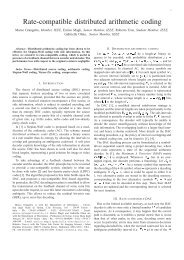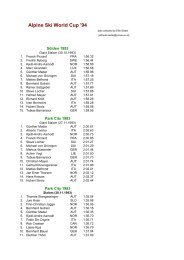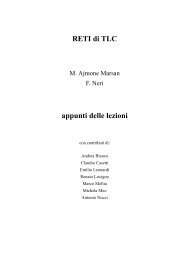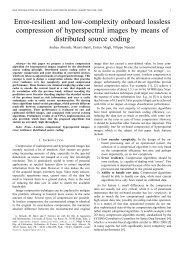Transform coding techniques for lossy hyperspectral data compression
Transform coding techniques for lossy hyperspectral data compression
Transform coding techniques for lossy hyperspectral data compression
You also want an ePaper? Increase the reach of your titles
YUMPU automatically turns print PDFs into web optimized ePapers that Google loves.
IEEE TRANSACTIONS ON GEOSCIENCE AND REMOTE SENSING (SUBMITTED DEC. 2005) 13<br />
LLL<br />
lines<br />
bands<br />
pixels<br />
Fig. 6.<br />
gain.<br />
Sub-cubes obtained by the 3D wavelet packet decomposition minimizing the cost function based on the <strong>coding</strong><br />
contain many high-valued coefficients that have to be retained, at the expenses of other coefficients<br />
that are discarded. There<strong>for</strong>e, the mismatch between the 3D coefficient selection and the separatedness<br />
of the DWPT trans<strong>for</strong>m makes it useless, and even disadvantageous, to per<strong>for</strong>m best basis selection.<br />
Comparing Fig. 7 and Fig. 5, it can be seen that the per<strong>for</strong>mance of the DWT1D2D trans<strong>for</strong>m is<br />
very similar to that of the DWP3D trans<strong>for</strong>m, but with a significantly reduced computational ef<strong>for</strong>t,<br />
since it is not necessary to compute the optimal basis. In fact, this trans<strong>for</strong>m has been selected in<br />
[16] <strong>for</strong> its favorable trade-off between per<strong>for</strong>mance and complexity.<br />
Continuing the study of spectrally separable trans<strong>for</strong>ms, Fig. 8 compares the DWT1D2D, DCT1D-<br />
DWT2D, and KLT1D-DWT2D trans<strong>for</strong>ms. Following the results described above, these trans<strong>for</strong>ms<br />
have been selected in order to compare different spectral decorrelators, using the 2D DWT <strong>for</strong> spatial<br />
decorrelation because of its effectiveness. Not surprising, the KLT turns out to be the best trans<strong>for</strong>m;<br />
since we are employing the same trans<strong>for</strong>m <strong>for</strong> all spectral vectors, the overhead of describing the<br />
trans<strong>for</strong>m matrix in the compressed file is negligible. The per<strong>for</strong>mance gain of the KLT1D-DWT2D<br />
with respect to the DWT1D2D is about 2 dB at high quality levels, and significantly more at low bitrates.<br />
However, as outlined in Sect. II-F.8, the KLT1D-DWT2D requires the estimation (and averaging)<br />
of as many covariance matrices as samples per band, followed by the solution of the eigenvector






